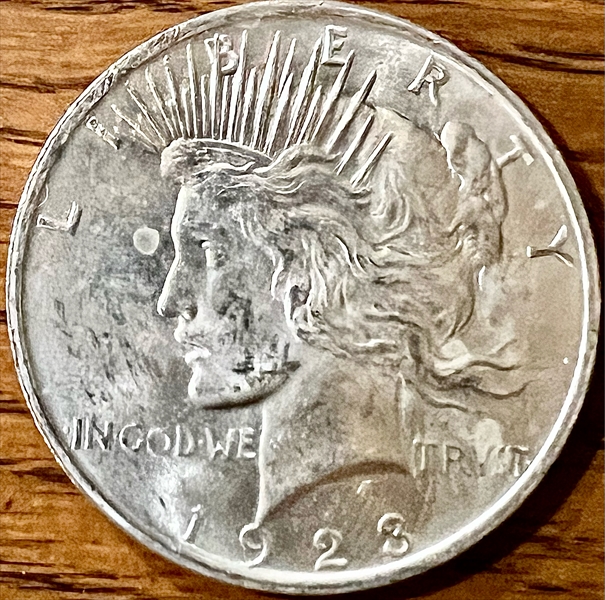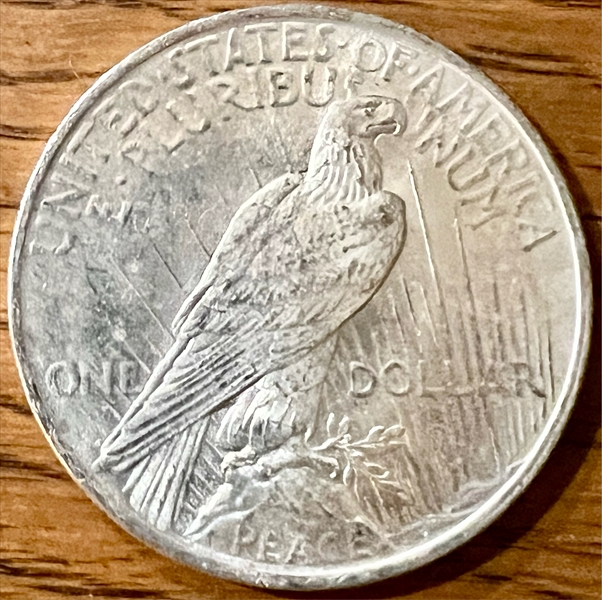1923 $1 ms63 PCGS号7360
专家评论
Ron Guth
The 1923 Peace Dollar is the second most common date of the type, second only to the 1922. Collectors will have no problem finding a nice example of this date, as tens of thousands have been certified in MS-63 and MS-64. In fact, for type purposes, the 1923 Peace Dollar is one of the easiest dates top find in top condition. MS-66 examples are affordable compared to other dates. Though pricey, an MS-67 1923 Peace Dollar can be found with relative ease. Most 1923 Peace Dollars exhibit a strong strike and decent eye appeal. Luster ranges from frosty white to a hard, metallic sheen.
Q. David Bowers
The following narrative, with minor editing, is from my "Silver Dollars & Trade Dollars of the United States: A Complete Encyclopedia" (Wolfeboro, NH: Bowers and Merena Galleries, Inc., 1993).Coinage Context
The 1923 Peace dollar mintage is the second largest in the series, after the record-breaking 1922. There was no need for more Peace dollars in circulation, for dollars were not popular in commerce in the East; thus, most went into storage.
Numismatic Information
Once rare: Apparently, relatively few 1923 Peace dollars were released within a few years of striking. However, the issue was not considered to be rare. By the 1930s, the 1923 Peace dollar was believed to be a common date, and little attention was paid to it.
On the numismatic market of the early 1940s it was slightly on the rare side and was often absent from dealer offerings. In 1945 at the sale of the Frederick C.C. Boyd Collection (billed as "The World's Greatest Collection" by the auctioneer, the Numismatic Gallery) an Uncirculated 1923 crossed the block at $9, outranking in price all other Peace dollars. This was twice the price of $4.50 registered by the 1934-S. At the time the 1925 Peace dollar, also later to become extremely common, fetched $6, the second highest price for a coin of this design type.
Quantities were distributed through Eastern banks a couple of years later, and by mid-1947 the 1923 Peace dollar had fallen from its height and was solidly ensconced in the common date category. An Uncirculated piece fetched only $2.75 in B. Max Mehl's mail bid sale of the Will W. Neil Collection, an event which saw a 1934-S soar to $13.50. If there was one constant in the Peace dollar market in the 1940s, that constant was change: many different varieties went from common to rare and back to common again, or from rare to common, or, in the instance of the 1934-S, from common to rare and stayed there. The market did not stand still.
Bags of 1923 dollars were readily available from November 1945 (when dozens of bags were turned loose through Chicago banks) through at least the late 1950s. These piled up in Eastern and Midwestern bank vaults and were ignored by just about everyone, including dealer specialists in dollars.
Hoard coins: Bags of 1923 Peace dollars descended upon the channels of commerce in the mid-1940s. Bags remained common in bank holdings until the early 1960s and were paid out by the Treasury until the early months of 1964. After that, they remained common in the hands of investors (in particular) and dealers.
In all grades from well-worn to high-grade Mint State, the 1923 may account for 5% to 10% of the silver dollars in existence today, Wayne Miller suggested in his 1982 text on the subject.
Circulated grades: The 1923 Peace dollar is extremely common in VF-20 to AU-58 grades, and with the 1922, 1924, and 1925, is one of the most plentiful of all Philadelphia Mint Peace issues.
Mint State grades: The 1923 Peace dollar is very plentiful in Mint State, in all grades from MS-60 through MS-65 or even higher. In fact, it may well be the commonest of all Uncirculated Peace dollars.
Many 1923 Peace dollars, like those dated 1922 and like certain other coins of the era, are often seen with milky-white spots that are virtually impossible to remove. These are believed to be the residue from dilute sulfuric acid at the Mint. Some coins have yellowish stains, particularly around the rims.
The typical 1923 Peace dollar is well struck and has nice, frosty mint lustre. One does not have to cherrypick to find an aesthetically pleasing specimen of this date. For this reason, it is a good "starter coin" for a collection. Moreover, the 1923 is one of the least expensive dates.
Many coins are bagmarked and/or stained, but enough others exist, that such impaired pieces can be ignored. Leave them for investors!
To reiterate: In early 1945 the 1923 Peace dollar was considered to be the rarest of all Peace dollars in Mint State, but today it is the commonest. All of this makes fascinating reading today, for the 1923 has been considered to be common for many years, and it is hard to imagine that it was once otherwise.
Something to watch for: Van Allen and Mallis note that some 1923 dollars exist with the reverse rotated 25% to 100% clockwise from the normal alignment.
Varieties
Circulation strikes:
1. Breen-5717. Hub combination II-B2. VAM-I.
Most of one standard variety. VAM-2 and 3 have slight doubling.
Van Allen and Mallis list several with interesting die breaks, including "Whisker Jaw" with raised ridge of metal due to die break (VAM-1A), "Extra Hair" with die break in hair (VAM-1B), "Tail on 0" with die break at lower part of 0 in DOLLAR (VAM-1C), and "Whisker Cheek" with vertical ridge of silver on cheek from die break (VAM-1D).
Dies prepared: Obverse: Unknown; Reverse: Unknown.
Circulation strike mintage: 30,800,000
Estimated quantity melted: Unknown
Commentary
This is one of the' most' Common Peace silver dollar issues.
Additional Information
Silver Dollars in the West The Numismatist, April 1923, carried this item:
"Worn Silver Dollars in the West to be Replaced: The silver dollars in circulation in the West are reported to be badly worn, and banks have refused to replace them because they have been compelled to pay expressage on new ones sent from Washington for the purpose. A bill recently introduced in Congress by Senator Smoot will permit the government to pay expressage on 40 million new coins to be sent at once."
Pittman Act Report
The Numismatist, May 1923, updated readers as follows:
"Pittman-Act Purchases of Silver Soon to Stop: The director of the Mint has announced that the amount of silver bullion remaining to be purchased under the Act of April 23, 1918, commonly known as the Pittman Act, is now about 20 million fine ounces. Purchases at the fixed price of $1 per ounce, 1,000 fine, as provided by the act, will stop as soon as the required amount has been purchased, and since the production of domestic silver amounts to between six and seven million ounces per month, the probabilities are that this will be about July 1, 1923.
"Every effort will be made in closing purchases under the Pittman Act to make sure that American miners receive the benefits of the act up to the latest possible date and that so far as practicable the miners continue to get the fixed price of $1 per ounce for their silver until the same date in all sections of the country, without discrimination as between different sections. With this in mind, the director of the Mint has always required, in connection with purchases of silver under the act, supporting affidavits from the American miners showing that settlement has been made with them on the basis of the fixed price of $1 per ounce, adjusted to the equivalent price of silver .999 fine and cost of delivery from refinery to mint, and in handling the remaining purchases the director is imposing further restrictions, applicable particularly to the large sellers of silver, that will assure payments to miners on the basis of $1 per ounce to the latest possible date throughout the country and the simultaneous discontinuance of such payments when the limit under the act has been reached."
More on the Pittman Act
The Numismatist, July 1923, told the following:
"Buying Silver for Coinage Now at an End: Treasury purchases of silver ended June 1, when offers estimated at 200,000 ounces had been received under the Pittman Act. Since the offers were on the basis of estimates, Director Scobey had no way of ascertaining definitely whether the amount required by the law would be entirely filled. Consequently he continued to receive and file offers until June 15.
"The 200,000 ounces purchased are to replace the silver dollars loaned by the Treasury to Great Britain for use in India during the war. When that bullion is again in its vaults the government will be out of the silver market. Officials believe the Treasury will have no further need for additional stocks for several years."
PCGS #
7360
设计师
Anthony de Francisci
边缘
Reeded
直径
38.10 毫米
重量
26.73 克
铸币数量
30800000
金属成分
90% Silver, 10% Copper
更高评级数量
134700
评级较低的钱币数量
19325
地区
The United States of America
价格指南
PCGS 数量报告
拍卖 - PCGS 评级的
拍卖 - NGC 评级的
稀有性和存量估计 了解更多
| 所有评级 | 9000000 |
| 60或以上 | 3500000 |
| 65或以上 | 100000 |
| 所有评级 | R-1.0 |
| 60或以上 | R-1.0 |
| 65或以上 | R-2.0 |
| 所有评级 | 17 / 23 TIE |
| 60或以上 | 22 / 23 TIE |
| 65或以上 | 23 / 23 |
| 所有评级 | 18 / 24 TIE |
| 60或以上 | 23 / 24 TIE |
| 65或以上 | 24 / 24 |


























